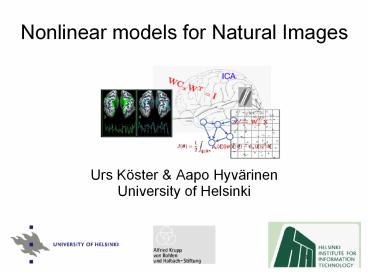Nonlinear models for Natural Images - PowerPoint PPT Presentation
1 / 15
Title:
Nonlinear models for Natural Images
Description:
Nonlinear models for Natural Images Urs K ster & Aapo Hyv rinen University of Helsinki * – PowerPoint PPT presentation
Number of Views:94
Avg rating:3.0/5.0
Title: Nonlinear models for Natural Images
1
Nonlinear models for Natural Images
- Urs Köster Aapo Hyvärinen
- University of Helsinki
1
2
Overview
- Limitations of linear models
- A hierarchical model learns Complex Cell pooling
- A Horizonal product model for Contrast Gain
Control - A Markov Random Field generalizes ICA to large
images
2
3
1. Limitations of ICA image models
- Natural images have complex structure, cannot be
modeled as superpositions of basis functions - Linear models ignore much of the rich
interactions between units - Modeling the dependencies leads to more abstract
representations - Variance dependencies are particularly obvious
structure not captured by ICA - Model with (complex cell) pooling of filter
outputs - hierarchical models - Alternative Model dependencies by gain control
on the pixel level
Schwartz Simoncelli 2001
4
Gain Control in Physiology
- Divisive normalization is common throughout the
brain, see e.g. the normalization model for
primary visual cortex - Previous work has analyzed the effect of gain
control on the cortical level - We use a statistical model for gain control on
the LGN level - Important effects on subsequent cortical
processing
Normalization modelCarandini and Heeger,1994
5
A hierarchical model estimated with Score
Matching learns Complex Cell receptive fields
6
2. Two Layer Model estimated with Score Matching
- Define an energy based model of the form
- Squaring the outputs of linear filters
- Second layer linear transform v
- Nonlinearity that leads to a super-gaussian pdf.
- Cannot be normalized in closed form. Estimation
with Score Matching makes learning possible
without need for Monte Carlo methods or
approximations
6
7
Results
- The second layer learns to pool over units with
similar location and orientation, but different
spatial phase - Following the energy model of Complex Cells
without any assumptions on the pooling - Estimating W and V simultaneously leads to a
better optimum and more phase invariance of the
higher order units
Some pooling patterns
8
Learning to perform Gain Control with a
Horizontal Product model
9
Multiplicative interactions
A horizontal network model
Horizontal layers
- Two parallel streams or layers on one level of
the hierarchy - Unrelated aspects of the stimulus are generated
separately - Observed data is generated by combining all the
sub-models
- Data is described by element-wise multiplying
outputs of sub-models - Can implement highly nonlinear (discontinuous)
functions - Combine aspects of a stimulus generated by
separate mechanisms
10
The model
- Definition of the model
- Likelihood
- Constraints B and t are non-negative, W
invertible - g(.) is a log-cosh nonlinearity (logistic
distribution) - t has a Laplacian sparseness prior
10
11
Results
First layer W 4 units in B
First layer W 16 units in B
12
Second Layer Contrast Gain Control
- Emergence of a contrast map in the second layer
- It performs Contrast Gain Control on the LGN
level (rather than on filter outputs) - Similar effect to performing divisive
normalization as preprocessing - The model can be written as
- Something impossible to do with hierarchical
models
True image patches
Reconstruction from As only
Modulation from Bt
13
The big picture A Markov Random Field
generalizes ICA to arbitrary size images
14
4. Markov Random Field
- Goal Define probabilities for whole images
rather than small patches - A MRF uses a convolution to analyze large images
with small filters - Estimating the optimal filters in an ICA
framework is difficult, the model cannot be
normalized - Energy based optimization using Score Matching
15
Model estimation
- The energy (neg. log pdf) is
- We can rewrite the convolution
- where xi are all possible patches from the image,
wk are the different filters - We can use score matching just like in an
overcomplete ICA model - The MRF is equivalent to overcomplete ICA with
filters that are smaller than the patch and
copied in all possible locations.
16
Results
- We can estimate MRF filters of size 12x12 pixels
(much larger than previous work, e.g. 5x5) - This is possible from 23x23 pixel images, but
the filters generalize to images of arbitrary
size - This is possible because all possible overlaps
are accounted for in the (2 n -1) size
image - Filters similar to ICA, but less localized
(since they need to explain more of the
surrounding patch) - Possible applications in denoising and filling-in
16































